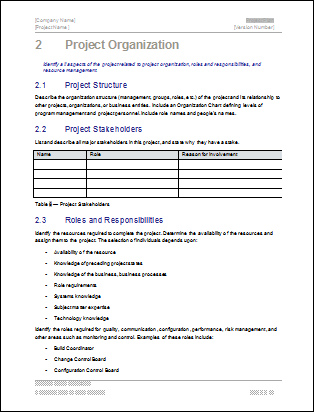5 Tips for Smooth Project Completion
The Project Management Initiative tells us that there are steps that must be followed in order to complete a project that knocks the socks off of your boss. Projects in the business world have a lifecycle. Although you may be the most organized person at home, completing a professional project takes more than simple organizational tips. Don't be overwhelmed by an impending project deadline; the steps come naturally. In fact, you have probably followed the steps in previous projects without knowing it.
1.Initiation
The initiation of your project involves coming up with the goal. What is it that you want to accomplish? Once you determine the goal of your project, write the goal in solid terms with a specified timeframe. Define the scope of your project, appoint a project manager, and determine the milestones of the project. It is during the initiation phase that you will also want to select project group members with whom you will work.
2.Planning
The next thing you will do is plan your project in detail. Breakdown the project into smaller desired outcomes. Next, determine how much time you will dedicate to these smaller outcomes. Try to be realistic in your breakdown of time. Don't assign 10 minutes to an outcome that will take three hours to achieve. Decide in what order your outcomes will be completed. This is called a sequence of activities. Finally, brainstorm with your team members to determine all of the things that can make your project fail. Determine how you will handle these issues if they arise.
3.Execution
When you hit the execution phase of your project, you start and continue to work on it, following your plan closely. In the beginning stages of your project, you should have determined how you would achieve each outcome. Avoid straying from your project plan; you should already have determined how you would handle mistakes and road blocks.
4.Monitoring
As you are executing your plan, the unexpected may arise. A group member may fall ill, your boss may decide to change the ultimate goal of the project, financial issues may occur, or time constraints may arise. Continuously monitor and evaluate your progress during the execution phase. Make any adjustments that are necessary to keep the group on task and the project humming along. As you are monitoring your project, keep anyone in the loop that needs to be.
5.Closing
When your project is complete, you or a team member should write a formal summary of your project. Included in the report should be notes regarding the completion of each milestone, any changes that were made not in the original plan, any difference in the projected and actual budgets, the impact of the project, and any lessons learned by the team during the execution of the project. Do not consider your project closed until this report is written and turned in to the powers-that-be.
Although it may seem tedious and unnecessary, following a project management plan will actually help your project move along more smoothly. From initiation to closing, your project will go exactly as you intend provided you construct a proper plan. Once you understand how to complete a project following this model, you'll find yourself utilizing the same steps for future projects with very little thought.
Brett Harris is a freelance writer for education blogs. If a career as a project manager is something you'd like to pursue then you might be interested in the Top Online Bachelors in Project Management Degree Programs offered at several colleges.
1.Initiation
The initiation of your project involves coming up with the goal. What is it that you want to accomplish? Once you determine the goal of your project, write the goal in solid terms with a specified timeframe. Define the scope of your project, appoint a project manager, and determine the milestones of the project. It is during the initiation phase that you will also want to select project group members with whom you will work.
2.Planning
The next thing you will do is plan your project in detail. Breakdown the project into smaller desired outcomes. Next, determine how much time you will dedicate to these smaller outcomes. Try to be realistic in your breakdown of time. Don't assign 10 minutes to an outcome that will take three hours to achieve. Decide in what order your outcomes will be completed. This is called a sequence of activities. Finally, brainstorm with your team members to determine all of the things that can make your project fail. Determine how you will handle these issues if they arise.
3.Execution
When you hit the execution phase of your project, you start and continue to work on it, following your plan closely. In the beginning stages of your project, you should have determined how you would achieve each outcome. Avoid straying from your project plan; you should already have determined how you would handle mistakes and road blocks.
4.Monitoring
As you are executing your plan, the unexpected may arise. A group member may fall ill, your boss may decide to change the ultimate goal of the project, financial issues may occur, or time constraints may arise. Continuously monitor and evaluate your progress during the execution phase. Make any adjustments that are necessary to keep the group on task and the project humming along. As you are monitoring your project, keep anyone in the loop that needs to be.
5.Closing
When your project is complete, you or a team member should write a formal summary of your project. Included in the report should be notes regarding the completion of each milestone, any changes that were made not in the original plan, any difference in the projected and actual budgets, the impact of the project, and any lessons learned by the team during the execution of the project. Do not consider your project closed until this report is written and turned in to the powers-that-be.
Although it may seem tedious and unnecessary, following a project management plan will actually help your project move along more smoothly. From initiation to closing, your project will go exactly as you intend provided you construct a proper plan. Once you understand how to complete a project following this model, you'll find yourself utilizing the same steps for future projects with very little thought.
Brett Harris is a freelance writer for education blogs. If a career as a project manager is something you'd like to pursue then you might be interested in the Top Online Bachelors in Project Management Degree Programs offered at several colleges.





Comments
Post a Comment